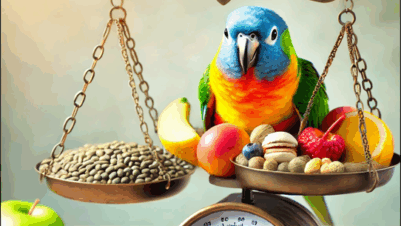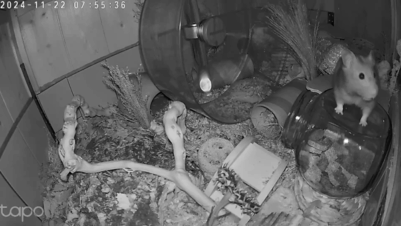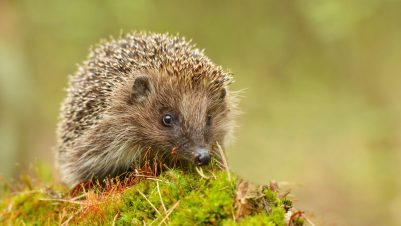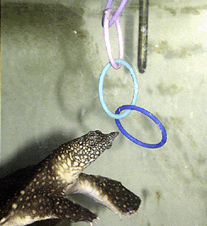Rodents can be popular and familiar companion species – for many, the first introduction to having a pet of their own to care for. Readers have likely taken care of a golden hamster (Mesocricetus auratus), guinea pig (Cavia porcellus), fancy rat (Rattus norvegicus domestica) or gerbil (Meriones unguiculatus) at some stage of their life. There is, however, a growing body of hobbyists that enjoy keeping and breeding other species of more unusual and exotic rodents – some of which can also be kept as family pets. Examples of these rodent species are listed below.
- Degu (Octodon degus): native to Chile, degus are highly social and are known for their intelligence and ability to form strong bonds with their owners. Degus are diurnal and live in burrows but forage above ground
- Long-tailed chinchilla (Chinchilla lanigera): the ancestor of domestic chinchillas. Chinchillas are very social with a crepuscular (morning and evening) behaviour pattern. Their famously dense, soft fur is an adaptation for life at high altitudes
- African pygmy dormouse (Graphiurus murinus): nocturnal and full of energy, thus requiring stimuli at the appropriate time of their day. Dormouse care is relatively complicated compared to other rodents, so they should only be kept by specialists
- Duprasi (Pachyuromys duprasis): also known as the fat-tailed gerbil, this desert-dwelling rodent stores fat (as a water and energy supply) in its tail. Duprasi are generally solitary but can sometimes be found in small colonies. They consume a mixed diet of insects and plant material
- Striped grass mice: species of mouse in the genus Lemniscomys that live in grasslands. Diurnal and very active, they may not take well to handling and can be stressed by human interaction.
Rodent health is all about teeth
Like all rodents, the health and welfare of these unusual and exotic species depends on their tooth condition and dental health (Legendre, 2003; Saunders, 2009). Rodents have a pair of continuously growing incisors in the top and bottom jaw (Klevezal, 2010). These incisors are used for gnawing and for the preparation of food before chewing and swallowing. In some species of rodent, the molars at the back of the mouth are also constantly growing (as an adaptation to a high-fibre diet). If the animal is not provided with opportunities for gnawing, a rodent’s incisors can become overgrown, causing injury and damage to the mouth and skull (Legendre, 2003). Similarly, molars may be maloccluded (grow out of line and form spurs) if an animal is not fed a high-fibre diet that requires mechanical breakdown by the teeth (Müller et al., 2015). As such, knowing how a rodent species forages and what types of food they are selecting is essential for the maintenance of good dental health under human care. Many veterinary-related issues (such as poor body condition, gut stasis, dental abscesses and eye problems) can be prevented by feeding a rodent the right type of diet for its ecology (Figure 1) (Grant, 2014; Yeates and Bauman, 2019).
Remember, before getting any exotic pet, it is crucial to thoroughly research their care requirements to ensure you can provide a suitable environment for them. Just because these rodent species resemble more familiar companion hamsters, gerbils or rats, they will have unique aspects of their biology, behaviour and ecology that must be catered for when kept as a household pet.

| Did you know we offer CPD membership plans? Get access to thousands more articles, hundreds of short courses and easily fulfil your annual CPD requirements. Find out more here. |
Creating an enrichment enclosure
Owners and potential owners should invest time and effort in researching the housing and husbandry of their new exotic rodent pet. Providing suitable environmental enrichment for unusual species of rodents is essential for their physical and mental welfare (Yeates and Bauman, 2019). The type of enrichment that can be provided will depend on the type of housing that has been selected. For example, burrowing species in a large glass aquarium will have a wider choice of substrates to utilise than if they were housed in a wired but taller cage (that gives more opportunities for climbing). It is important to remember that many of these species have not had a long history under human care and have yet to be truly domesticated. Being tame is not the same as being domesticated (and therefore adapted to a human-created environment), so ensuring that housing, husbandry and enrichment provides for highly motivated behaviour patterns that the rodent needs to perform each day is important. Key aspects of daily husbandry, such as the overall social environment provided, and dietary staples, such as forage, are enriching in their own right because the rodent species has evolved to engage with these stimuli for a large part of their day (Figure 2).

Examples of enrichment for exotic rodents include:
- Burrowing materials: providing materials like shredded paper, hay or soil can allow rodents to exhibit natural digging behaviours
- Variety of substrates: offering different substrates such as sand, leaf litter and wood shavings can promote behavioural diversity. This can be especially important to species that spend a long time exploring their environment when foraging, eg degus
- Climbing structures: many rodents enjoy climbing, and some are arboreal (such as African pygmy dormice), so providing branches or shelves in their enclosure can encourage natural behaviours and can also reduce the performance of abnormal behaviour (Lang et al., 2020)
- Dust baths: especially important for chinchillas, who need regular dust baths to maintain their fur quality and condition (Hsu et al., 2015). Provide a dust bath area with chinchilla-specific dust (available from reputable pet stores) for them to roll around in
- Chew toys: all rodents, as mentioned above, have continuously growing teeth, so providing safe chew toys made of wood (non-toxic, non-treated) is essential
- Vertical space: many rodents are excellent jumpers and climbers, so offering multi-level cages with shelves and platforms for them to climb onto and explore helps keep them active and engaged
- Habitat complexity: rodents will appreciate a variety of textures and structures in their environment that provide for locomotion and exploration. Incorporate branches, shelves and platforms for climbing, as well as ropes or hammocks for resting
- Sensory enrichment: different textures and scents, such as dried herbs or flowers (ensure they are safe for the species they are destined for), can provide an outlet for many different behaviours. Rotate such enrichment items regularly to keep things interesting and reduce the chance of habituation
- Areas of deep sand: desert-dwelling species, such as duprasi and other gerbil species, dig burrows to escape the desert heat. Providing a deep layer of sand substrate can mimic their natural habitat and allow for digging and burrowing that would take up a large part of their daily time budget
- Running wheels: more commonly associated with pet hamsters, wheels are useful for a range of rodents to expend energy. Many species travel long distances in the wild, so providing a wheel can help alleviate motivation to travel and roam. Please check that a wheel is the correct size and structure (solid or spoked) before introducing it to your rodent pets
- Hideouts and tunnels: be creative and provide your rodents with tunnel systems and hiding spots made of cardboard or PVC pipes so that they can feel secure in their environment. The more hiding places a rodent has, the more secure they will feel to come out and explore their surroundings
- Diverse foraging opportunities: hide suitable treats or food pellets in various locations around their enclosure or inside foraging toys to encourage exploration and mental stimulation
- Social interaction: some species, such as degus and chinchillas, are highly social animals and only thrive in groups. Knowledge of the social system of this species in the wild can help replicate harmonious, welfare-positive group housing at home
- Social choice: some species are solitary or will socialise at specific times or on their own terms, for example the duprasi. Ensure any housing or enclosure is set up to allow animals to retreat from each other and be alone when they choose
Such an enriched environment (Figure 3) needs to meet the climatic requirements of the species, too. Ensure that temperature and ventilation is appropriate for the species. Chinchillas, for example, easily succumb to heat stroke (Hsu et al., 2015) so maintain a preferred indoor temperature range of 10 to 16oC. Ensure the enclosure is escape-proof and free of hazards such as sharp edges, toxic materials or small gaps where a rodent could get stuck. Regularly inspect (daily) your rodent’s enclosure for any signs of wear or damage that could pose risks to the animals and be a likely avenue of escape.

Final thoughts
Following the key rules listed below will provide owners with the best chances of keeping their exotic rodents healthy and disease-free, with the potential to obtain maximum longevity:
- Correct diet to maintain dental health and correct tooth growth
- Creating the appropriate social group
- Managing climate (eg temperature and humidity) according to a species’ needs
- Providing an interesting and stimulating enclosure of an appropriate size and shape for the species being housed
- Working with the individual animal to understand their temperament, their personality and how they want to engage with their owner to avoid stress and build a positive relationship
Seek out a veterinary surgeon with expertise in such species before you select one as a new pet. Many of the health concerns can be similar to those seen in more familiar rodents, but species-specific needs will still be apparent. Please note, if you search online for information on exotic rodent care, be careful with the quality and accuracy of source material that is available. Information on the care of African pygmy hedgehogs (Atelerix albiventris) and sugar gliders (Petaurus breviceps), for example, commonly appears when searching for exotic rodent care, even though neither of these species are rodents and they have very specific needs based on their own ecology and behaviour.









